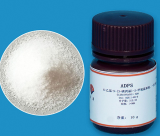Chinese VersionChina Suppliers > Hubei new DE sheng material science and technology co., LTD. > The Color Development Principle of Color Source Substrate ADPS
- Search Product
-
-
- Region :China/Hubei
- Tel : +86-18971041571
- Fax :
- Email :vickyzhao@whdschem.com
- URL :
- Add :Guanggu United Science and Technology City C8, Ezhou City, Hubei Province
- Details for The Color Development Principle of Color Source Substrate ADPS
-
The Color Development Principle of Color Source Substrate ADPS
Category : Other Chemicals

CAS NO : 82611-88-9 EC NO : MF : C12H18NNaO4S MW : 295.3304 Specification : White Powder Packing : 500g/bottle Product description : The chromogenic substrate ADPS is a commonly used chromogenic substrate for horseradish peroxidase HRP or peroxidase POD. Its chemical name is N-ethyl-N - (3-sulfopropyl) -3-methoxyaniline sodium salt dihydrate, which is highly water-soluble and a new type of Trinder's reagent. Coupled oxidation system: ADPS is a new type of Trinder's reagent developed on the basis of traditional Trinder's reagent phenol or aniline, which is used as an indicator system for hydrogen peroxide H2O2 coupling in biochemical detection. This system is widely used, including traditional chromogenic phenols, new Trinder's reagents (such as ADPS reagents, MAOS, TOOS, etc.), etc. Under the action of peroxidase, H2O2 can oxidize a single or paired colorless pigment to a colored pigment, resulting in an increase in absorbance at a certain wavelength. Therefore, it can be used to determine the concentration or activity of substances. Single pigments such as TMB, ABTS, etc. used for this indicator system; Paired pigments contain phenols, 4AA, MBTH, and DMA. ADPS color rendering principle: Under the catalytic action of POD, H2O2 couples with ADPS and 4AA (4-aminoantipyrine) to produce quinone imines, resulting in an increase in absorbance at 500nm. Taking the detection of Glu (blood sugar) as an example, Glu reacts with oxygen and water to generate gluconic acid and hydrogen peroxide H2O2 (hydrogen peroxide) under the catalysis of GOD. The generated hydrogen peroxide can be measured using the coupled oxidation system of ADPS, and the degree of absorbance increase is proportional to Glu. The blood sugar content can be measured by measuring the increase in absorbance using spectrophotometer. Uses : New trinder's reagent Synonyms : ADPS;sodium 3-[ethyl(3-methoxyphenyl)amino]propane-1-sulfonate;N-Ethyl-N-(3-sulfopropyl)-3-methoxyaniline sodium salt;ADPS(ESPAS); Molecular Structure : 
- more>>Other Products
-
- • Biological buffer 3- [N, N-di (hydroxyethyl) amino] -2-hydroxypropanesulfonic acid DIPSO
- • Luminol Sodium Salt
- • 4-Aminophthalhydrazide
- • acridinium ester DMAE-NHS
- • acridinium ester NSP-DMAE-NHS
- • Acridine hydrochloride NSP-SA
- • Acridine hydrochloride NSP-SA-NHS
- • NSP-SA-ADH
- • acridinium ester ME-DMAE-NHS TOOS; 3-(N-Ethyl-3-Methylanilino)-2-Hydroxypropanesulfonic Acid Sodium Salt
- • TOPS; Sodium 3-(N-Ethyl-3-Methylanilino)Propanesulfonate; N-Ethyl-N-Sulfopropyl-M-Toluidine Sodium Salt
- • ADOS Sodium 3-(Ethyl(3-Methoxyphenyl)Amino)-2-Hydroxypropane-1-Sulfonate Dihydrate
- • ADPS N-Ethyl-N-(3-Sulfopropyl)-3-Methoxyaniline Sodium Salt
- • ALPS N-Ethyl-N-(3-Sulfopropyl)Aniline Sodium Salt; Sodium 3-(Ethyl(Phenyl)Amino)Propane-1-Sulfonate; Sodium
- • DAOS; Sodium 3-((3,5-Dimethoxyphenyl)(Ethyl)Amino)-2-Hydroxypropane-1-Sulfonate
- • HDAOS; N-(2-Hydroxy-3-Sulfopropyl)-3,5-Dimethoxyaniline Sodium Salt
- • MADB N,N-Bis(4-Sulfobutyl)-3,5-Dimethylaniline Disodium Salt
- • MAOS N-Ethyl-N-(2-Hydroxy-3-Sulfopropyl)-3,5-Dimethylaniline Sodium Salt Monohydrate
- • DAB 3,3',4,4'-Biphenyltetramine Tetrahydrochloride